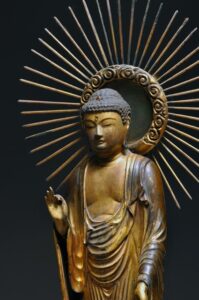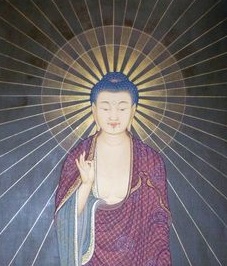The Path of Grace, The Heart of Gratitude
 Shin Buddhism was founded over 800 years ago in Japan by the religious reformer Shinran Shonin (1173- 1262). The Shin path is the latest branch of the greater 2,500 year old Pure Land tradition, established in India, by the historical Buddha. The word Shin means “heart” or “core,” so Shin Buddhism can mean the Heart of Buddhism, but the original Japanese name of Jodo Shinshu means the “True Essence (Heart) of the Pure Land Way.”
Shin Buddhism was founded over 800 years ago in Japan by the religious reformer Shinran Shonin (1173- 1262). The Shin path is the latest branch of the greater 2,500 year old Pure Land tradition, established in India, by the historical Buddha. The word Shin means “heart” or “core,” so Shin Buddhism can mean the Heart of Buddhism, but the original Japanese name of Jodo Shinshu means the “True Essence (Heart) of the Pure Land Way.”
A Brief History

Originally, in the 13th century, Shin was a lay reform movement during a decadent age of monastic spiritual materialism that focused more on power, fame, and gold than the original intent of Buddhism. In those days, women, butchers, samurai, fisherman, merchants etc. were forbidden to practice the dharma. It was Shinran Shonin and others who dared to challenge the religious elites, by returning the Buddhist religion to the original intent and teachings of the Buddha who stressed universal salvation, compassion, and simplicity of practice. As a result, Shin opened the gates of the Pure Land way to the suffering masses.
Long time after that, Shin was relegated as a minor fringe sect and was even oppressed by the government and the elites. Later, at one point, some monastics felt so threatened by this religious movement that they even attacked and burned down Shin temples. Regardless of these set backs, during these years and beyond, the Shin movement grew in numbers, appealing to the outcasts, morally weak, poor, destitute, and uneducated who were attracted to its all-inclusive attitude, spiritual egalitarianism, and reliance on simple daily practices.
Shin Buddhism arrived in the USA in the late 1900s with successive waves of Japanese immigrants, who concentrated in Hawaii and California. However, due to the ensuing intense racism and later on, being incarcerated in World War II Internment Camps in the 1940s, the Shin religion had kept a very low profile on the American landscape. Since the late 1990s, with the publication of popular Shin books like River of Fire, River of Water by Dr. Taitetsu Unno, Shin has seen an upsurge of interest as a spiritual path across the USA and beyond. This expansion is particularly vivid in Connecticut and Massachusetts through the efforts of the Northampton Shin Sangha and later the Buddhist Faith Fellowship of Connecticut. In the 21st century, Shin has become the largest Buddhist denomination in Japan with an active membership which spans across class boundaries and is now poised to take root in the Americas.
A Buddhism for Ordinary People
Shin Buddhism is a path of supreme optimism for busy people who have hefty work schedules, responsibilities, and families to take care of. As a consequence, it simplifies, condenses, and spiritualizes the seemingly complex and intellectual Buddhist teachings and practices, such as the Four Noble Truths, Eightfold Path, chanting, and meditation. It makes these teachings and practices more understandable and easier for ordinary lay people so they can experience their daily lives as a practical vehicle for inner transformation. Shin has nothing to do with believing in a morally flawed deities, a creator God for salvation or blindly following a creed, teaching, ritual or guru, but focuses on daily practice, open-minded reflection, and the direct and personal religious experience of the transcending, formless and living, Boundless Wisdom and Compassion, in an understandable form, as Amida Buddha.
seemingly complex and intellectual Buddhist teachings and practices, such as the Four Noble Truths, Eightfold Path, chanting, and meditation. It makes these teachings and practices more understandable and easier for ordinary lay people so they can experience their daily lives as a practical vehicle for inner transformation. Shin has nothing to do with believing in a morally flawed deities, a creator God for salvation or blindly following a creed, teaching, ritual or guru, but focuses on daily practice, open-minded reflection, and the direct and personal religious experience of the transcending, formless and living, Boundless Wisdom and Compassion, in an understandable form, as Amida Buddha.
Through the Shin path, one’s sufferings and burdens are naturally transmuted into a source of received wisdom and compassion, by which life is lived anew as a journey within honest self reflection, joy, and grace. This path of grace flows from the recognition that we are constantly embraced by Amida’s infinite compassion, which naturally awakens a deep sense of gratitude in our hearts that transforms our everyday actions into expressions of thankfulness. As a natural outcome of our practice, we are enjoined by the inconceivable activity of Amida, the Boundless Compassion, to be loving, kind, and gentle to ourselves and all sentient beings.
Our path focuses on the everyday spiritual life of ordinary working people and is open to all regardless of capacity, belief, moral status, age, race, gender or nationality. Following the spirit of its founder, Shinran Shonin, our American Shin community is spiritually egalitarian, that is, everyone is seen as a “fellow traveler along the path”, and has direct access to the dynamic working of the Great/Boundless Compassion. In the Shin religion, there are no monastics, monks or nuns, but there are teachers both ordained clergy and certified lay instructors. They are not seen as above everyone else or hold the secret keys to spiritual liberation, but are ordinary people, both men and women, who are just more learned or experienced spiritual seekers. Associate teachers, ministers and other certified teachers can marry and raise a family. Family life is not seen as a hindrance to spiritual development but as a natural function of being human. As a lay fellowship, we see ourselves fully engaged in life, participating neither in the ultimate and secular worlds but at the juncture of both dimensions; this is the essence of the Buddha’s Middle Way. It is for this reason, our founder, stated, “I am neither lay nor monk.”
Worldwide Adherents
Though little known in North America until just recently, Pure Land Buddhism and the Shin path are the most widely practiced form of Buddhism in Vietnam, China, Taiwan, Korea, Japan, and Singapore. The Pure Land tradition has the largest adherents of any type of Buddhism in the world. Moreover, Shin Buddhism, a branch of Pure Land, is the world’s largest Buddhist denomination with tens of millions of adherents. Furthermore there are pockets of Shin in the USA, Canada, Brazil, Argentina, Mexico, Puerto Rico, Singapore and Great Britain.
Due to the prolific number of books and centers focusing on Tibetan, Zen and Vipassana sects in North America, this news comes across with surprise for many Americans. We must remember that in Japan, just 2% of population practice Zen, and there are only 6 million Tibetans, and as for Vipassana, it is not even a Buddhist denomination but a meditation practice that is part of Theravada Buddhism. Here, we wish not to diminish the significance of these wonderful teachings but just to put into perspective the important role of the Pure Land tradition in the rest of the Buddhist world.